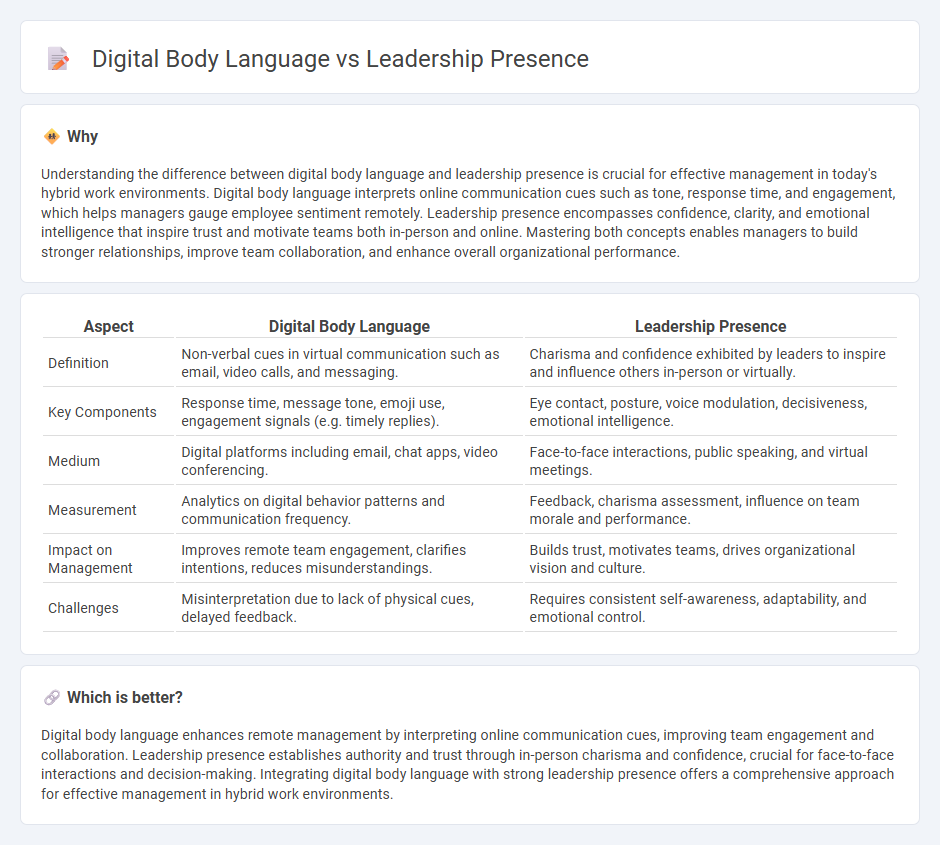
Digital body language encompasses nonverbal cues conveyed through virtual communication platforms, influencing perceptions of leadership presence in remote and hybrid work environments. Effective management requires understanding these subtle signals to build trust, inspire teams, and maintain authority outside traditional face-to-face settings. Explore how mastering digital body language can enhance your leadership presence in today's evolving workplace.
Why it is important
Understanding the difference between digital body language and leadership presence is crucial for effective management in today's hybrid work environments. Digital body language interprets online communication cues such as tone, response time, and engagement, which helps managers gauge employee sentiment remotely. Leadership presence encompasses confidence, clarity, and emotional intelligence that inspire trust and motivate teams both in-person and online. Mastering both concepts enables managers to build stronger relationships, improve team collaboration, and enhance overall organizational performance.
Comparison Table
| Aspect | Digital Body Language | Leadership Presence |
|---|---|---|
| Definition | Non-verbal cues in virtual communication such as email, video calls, and messaging. | Charisma and confidence exhibited by leaders to inspire and influence others in-person or virtually. |
| Key Components | Response time, message tone, emoji use, engagement signals (e.g. timely replies). | Eye contact, posture, voice modulation, decisiveness, emotional intelligence. |
| Medium | Digital platforms including email, chat apps, video conferencing. | Face-to-face interactions, public speaking, and virtual meetings. |
| Measurement | Analytics on digital behavior patterns and communication frequency. | Feedback, charisma assessment, influence on team morale and performance. |
| Impact on Management | Improves remote team engagement, clarifies intentions, reduces misunderstandings. | Builds trust, motivates teams, drives organizational vision and culture. |
| Challenges | Misinterpretation due to lack of physical cues, delayed feedback. | Requires consistent self-awareness, adaptability, and emotional control. |
Which is better?
Digital body language enhances remote management by interpreting online communication cues, improving team engagement and collaboration. Leadership presence establishes authority and trust through in-person charisma and confidence, crucial for face-to-face interactions and decision-making. Integrating digital body language with strong leadership presence offers a comprehensive approach for effective management in hybrid work environments.
Connection
Digital body language significantly enhances leadership presence by enabling leaders to convey confidence, empathy, and clarity through virtual communication platforms. Understanding and interpreting cues such as tone, pacing, and facial expressions in digital interactions fosters stronger trust and engagement among team members. Effective management leverages these insights to maintain influence and motivate teams despite physical distance.
Key Terms
Executive Presence
Executive presence combines confidence, clarity, and charisma essential for effective leadership, while digital body language encompasses non-verbal cues like posture, facial expressions, and eye contact in virtual settings. Both elements significantly impact communication, trust-building, and influence within organizations, with executive presence extending beyond physical meetings to digital interactions. Discover how mastering both leadership presence and digital body language can elevate your executive influence.
Virtual Communication
Leadership presence in virtual communication emphasizes confidence, clarity, and emotional intelligence to build trust and motivate teams through digital channels. Digital body language involves interpreting non-verbal cues such as tone, timing, and emoji use to enhance understanding and rapport in remote interactions. Explore effective strategies to master both leadership presence and digital body language for impactful virtual communication.
Nonverbal Cues
Leadership presence emphasizes confident posture, eye contact, and purposeful gestures that convey authority and trustworthiness in face-to-face interactions. Digital body language relies on timely responses, tone modulation, and virtual engagement signals such as nodding on video calls to build rapport and demonstrate attentiveness in remote settings. Explore the nuances of nonverbal communication and their impact on effective leadership in both physical and digital environments.
Source and External Links
Leadership Presence: Define it, Develop It, and Use It - Leadership presence is the ability to command a room, confidently share your ideas, and balance talking with listening to communicate persuasively and impactfully, while adapting to your audience's needs and energy.
How To Improve Your Leadership Presence - Her New Standard - Leadership presence is a blend of personal and interpersonal skills that inspire confidence, trust, and motivation in others, significantly influencing career advancement and opportunities.
How to Build Strong Leadership Presence: Simon Sinek's 5 Tips - Leadership presence is the ability to authentically connect with others, making them feel safe and inspired, and is developed through intentional practice rather than innate talent.
 dowidth.com
dowidth.com